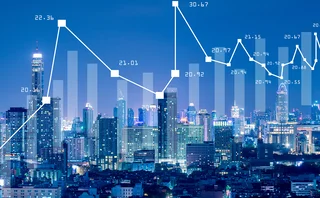
Beyond value-at-risk
There is, on balance, more chance of a major disruption to financial market stability this year than last. Credit spreads are squeezing ever tighter, despite several high-profile US bankruptcies last year; unsigned confirmations continue to plague the credit derivatives market; new, complex and relatively untested structured products are developing rapidly; and investors are putting money into ever more illiquid and esoteric instruments in the search for higher yields.
Then there's the increased threat of terrorist attacks, the risk of natural disasters caused by climate change and the potential impact of any global pandemic. Given the increasing globalisation of financial markets and products, a major disruptive event could cause ripple effects throughout the financial system, causing long-held correlations to shift, liquidity to dry up, and the processing and settlement of trades to slow to a trickle.
So says the UK Financial Services Authority (FSA) in its annual Financial Risk Outlook report. It makes interesting reading – and not just for those banks operating in the UK. The regulator advises banks to improve stress testing, to reassess inputs and test alternative assumptions. While stress testing is relatively well advanced for market risk, the FSA says the stress testing of other risks is still at the early stages, and points out that many firms have yet to fully incorporate stress testing into their risk management processes.
It is a criticism Risk has heard from several risk practitioners recently. Some risk managers argue that there's too much regulatory emphasis on value-at-risk, in some jurisdictions, to the detriment of stress testing and scenario analysis. VAR is a useful risk measure, but it perhaps doesn't present a complete picture of the risks a company faces.
The vast majority of financial institutions conduct stress testing in parallel with value-at-risk measurements. However, the danger is that risk managers fall into the trap of stress testing the same tired old scenarios – US dollar strengthens/weakens, rates go up/go down, oil price up/down. It seems most firms are running scenario analysis on the same events time after time, with many taking identical precautions to their competitors. But what happens if something out of the ordinary does occur – such as a major global pandemic, for instance, which would probably have a knock-on effect on the economy and affect global supply chains, but could also severely hinder banks' ability to process and settle trades and payments due to staff absences.
There's no way banks can stress test against every single possible scenario that could affect their business. However, risk managers do need to be a little more creative when considering potential disruptive events. At the very least, banks need to constantly review their inputs and make sure their stress tests reflect current sociopolitical trends. That means stress testing against more than just a 200-basis-point hike in rates.
Nick Sawyer, Editor
Only users who have a paid subscription or are part of a corporate subscription are able to print or copy content.
To access these options, along with all other subscription benefits, please contact info@risk.net or view our subscription options here: http://subscriptions.risk.net/subscribe
You are currently unable to print this content. Please contact info@risk.net to find out more.
You are currently unable to copy this content. Please contact info@risk.net to find out more.
Copyright Infopro Digital Limited. All rights reserved.
You may share this content using our article tools. Printing this content is for the sole use of the Authorised User (named subscriber), as outlined in our terms and conditions - https://www.infopro-insight.com/terms-conditions/insight-subscriptions/
If you would like to purchase additional rights please email info@risk.net
Copyright Infopro Digital Limited. All rights reserved.
You may share this content using our article tools. Copying this content is for the sole use of the Authorised User (named subscriber), as outlined in our terms and conditions - https://www.infopro-insight.com/terms-conditions/insight-subscriptions/
If you would like to purchase additional rights please email info@risk.net
More on Market risk
Market risk solutions 2023: market and vendor landscape
A Chartis Research report that examines the structural shifts in enterprise risk systems and the impact of regulations, as well as the available technology.
The new rules of market risk management
Amid 2020’s Covid-19-related market turmoil – with volatility and value-at-risk (VAR) measures soaring – some of the world’s largest investment banks took advantage of the extraordinary conditions to notch up record trading revenues. In a recent Risk.net…
ETF strategies to manage market volatility
Money managers and institutional investors are re-evaluating investment strategies in the face of rapidly shifting market conditions. Consequently, selective genres of exchange-traded funds (ETFs) are seeing robust growth in assets. Hong Kong Exchanges…
FRTB spurs data mining push at StanChart
Bank building “single golden source” of trade data in a bid to lower NMRF burden
Asian privacy laws obstruct FRTB data pooling efforts
Bank scepticism and regulatory hurdles likely to inhibit cross-border information sharing
Seizing the opportunity of transformational change
Sponsored Q&A: CompatibL, Murex and Numerix
Doubts grow over US FRTB implementation
Fragmented roll-out would price European banks “out of the market”
Basel group shake-up has banks hoping for FRTB changes
Barger and Durand replaced by BoE's Nesbitt; banks want fresh look at P&L test
Most read
- Breaking out of the cells: banks’ long goodbye to spreadsheets
- Too soon to say good riddance to banks’ public enemy number one
- Industry calls for major rethink of Basel III rules







